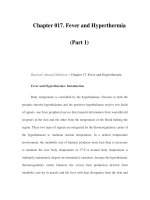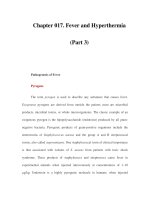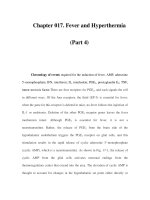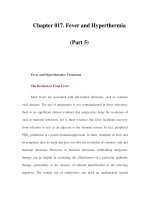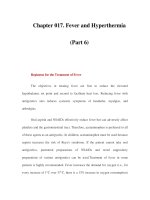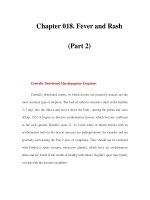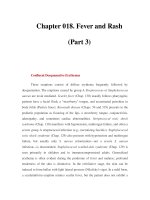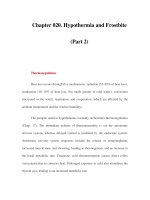Chapter 017. Fever and Hyperthermia (Part 2) docx
Bạn đang xem bản rút gọn của tài liệu. Xem và tải ngay bản đầy đủ của tài liệu tại đây (15.82 KB, 6 trang )
Chapter 017. Fever and Hyperthermia
(Part 2)
Hyperthermia
Although most patients with elevated body temperature have fever, there
are circumstances in which elevated temperature represents not fever but
hyperthermia (Table 17-1). Hyperthermia is characterized by an uncontrolled
increase in body temperature that exceeds the body's ability to lose heat. The
setting of the hypothalamic thermoregulatory center is unchanged. In contrast to
fever in infections, hyperthermia does not involve pyrogenic molecules (see
"Pyrogens," below). Exogenous heat exposure and endogenous heat production are
two mechanisms by which hyperthermia can result in dangerously high internal
temperatures. Excessive heat production can easily cause hyperthermia despite
physiologic and behavioral control of body temperature. For example, work or
exercise in hot environments can produce heat faster than peripheral mechanisms
can lose it.
Table 17-1 Causes of Hyperthermia Syndromes
Heat Stroke
Exertional: Exercise in higher-than-normal heat and/or humidity
Nonexertional: Anticholinergics, including antihistamines; antiparkinsonian
drugs; diuretics; phenothiazines
Drug-Induced Hyperthermia
Amphetamines, cocaine, phencyclidine (PCP),
methylenedioxymethamphetamine (MDMA; "ecstasy"), lysergic acid
diethylamide (LSD), salicylates, lithium, anticholinergics, sympathomimetics
Neuroleptic Malignant Syndrome
Phenothiazines; butyrophenones, including haloperidol and bromperidol;
fluoxetine; loxapine; tricyclic dibenzodiazepines; metoclopramide; domperidone;
thiothixene; molindone; withdrawal of dopaminergic agents
Serotonin Syndrome
Selective serotonin reuptake inhibitors (SSRIs), monoamine oxidase
inhibitors (MAOIs), tricyclic antidepressants
Malignant Hyperthermia
Inhalational anesthetics, succinylcholine
Endocrinopathy
Thyrotoxicosis, pheochromocytoma
Central Nervous System Damage
Cerebral hemorrhage, status epilepticus, hypothalamic injury
Source: After FJ Curley, RS Irwin, JM Rippe et al (eds): Intensive Care
Medicine, 3d ed. Boston, Little, Brown, 1996.Heat stroke in association with a
warm environment may be categorized as exertional or nonexertional. Exertional
heat stroke typically occurs in individuals exercising at elevated ambient
temperatures and/or humidities. In a dry environment and at maximal efficiency,
sweating can dissipate ~600 kcal/h, requiring the production of >1 L of sweat.
Even in healthy individuals, dehydration or the use of common medications (e.g.,
over-the-counter antihistamines with anticholinergic side effects) may precipitate
exertional heat stroke. Nonexertionalheat stroke typically occurs in either very
young or elderly individuals, particularly during heat waves. According to the
Centers for Disease Control and Prevention, there were 7000 deaths attributed to
heat injury in the United States from 1979 to 1997. The elderly, the bedridden,
persons taking anticholinergic or antiparkinsonian drugs or diuretics, and
individuals confined to poorly ventilated and non-air-conditioned environments
are most susceptible.Drug-induced hyperthermia has become increasingly
common as a result of the increased use of prescription psychotropic drugs and
illicit drugs. Drug-induced hyperthermia may be caused by monoamine oxidase
inhibitors (MAOIs), tricyclic antidepressants, and amphetamines and by the illicit
use of phencyclidine (PCP), lysergic acid diethylamide (LSD),
methylenedioxymethamphetamine (MDMA, "ecstasy"), or cocaine.Malignant
hyperthermia occurs in individuals with an inherited abnormality of skeletal-
muscle sarcoplasmic reticulum that causes a rapid increase in intracellular calcium
levels in response to halothane and other inhalational anesthetics or to
succinylcholine. Elevated temperature, increased muscle metabolism, muscle
rigidity, rhabdomyolysis, acidosis, and cardiovascular instability develop within
minutes. This rare condition is often fatal. The neuroleptic malignant syndrome
occurs in the setting of neuroleptic agent use (antipsychotic phenothiazines,
haloperidol, prochlorperazine, metoclopramide) or the withdrawal of
dopaminergic drugs and is characterized by "lead-pipe" muscle rigidity,
extrapyramidal side effects, autonomic dysregulation, and hyperthermia. This
disorder appears to be caused by the inhibition of central dopamine receptors in
the hypothalamus, which results in increased heat generation and decreased heat
dissipation. The serotonin syndrome, seen with selective serotonin uptake
inhibitors (SSRIs), MAOIs, and other serotonergic medications, has many
overlapping features, including hyperthermia, but may be distinguished by the
presence of diarrhea, tremor, and myoclonus rather than the lead-pipe rigidity of
the neuroleptic malignant syndrome. Thyrotoxicosis and pheochromocytoma can
also cause increased thermogenesis.
It is important to distinguish between fever and hyperthermia since
hyperthermia can be rapidly fatal and characteristically does not respond to
antipyretics. In an emergency situation, however, making this distinction can be
difficult. For example, in systemic sepsis, fever (hyperpyrexia) can be rapid in
onset, and temperatures can exceed 40.5°C. Hyperthermia is often diagnosed on
the basis of the events immediately preceding the elevation of core temperature—
e.g., heat exposure or treatment with drugs that interfere with thermoregulation. In
patients with heat stroke syndromes and in those taking drugs that block sweating,
the skin is hot but dry, whereas in fever the skin can be cold as a consequence of
vasoconstriction. Antipyretics do not reduce the elevated temperature in
hyperthermia, whereas in fever—and even in hyperpyrexia—adequate doses of
either aspirin or acetaminophen usually result in some decrease in body
temperature.
